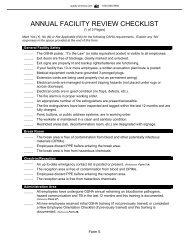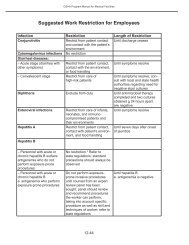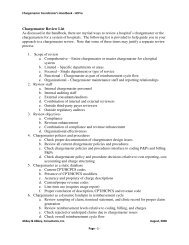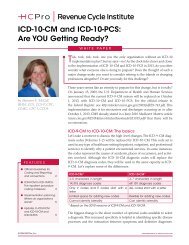Sepsis and Septicemia: Clear Up Coding and ... - HCPro Blogs
Sepsis and Septicemia: Clear Up Coding and ... - HCPro Blogs
Sepsis and Septicemia: Clear Up Coding and ... - HCPro Blogs
Create successful ePaper yourself
Turn your PDF publications into a flip-book with our unique Google optimized e-Paper software.
2 Present on Admission: Accurate reporting to ensure appropriate reimbursement October 2009<br />
For example, bacteremia, which refers to the laboratory finding of bacteria<br />
in the bloodstream through a positive blood culture only, can progress to<br />
septicemia. But note that bacteremia denotes a laboratory finding, whereas<br />
septicemia denotes acute illness. Bacteremia progresses to septicemia only<br />
when there is a more severe infectious process or an impaired immune system.<br />
Coders should be aware of the difference between these two conditions<br />
<strong>and</strong> consult the physician when the diagnosis is not clearly differentiated,<br />
according to the <strong>Coding</strong> Clinic, Volume 17, Number 2, second quarter 2000.<br />
Negative or inconclusive blood cultures do not preclude a diagnosis of septicemia<br />
or sepsis in patients with clinical evidence of the condition. Prior use<br />
of antibiotics by the patient or technical issues surrounding blood sampling<br />
can sometimes lead to a negative or inconclusive result. In fact, only 28% of<br />
patients with sepsis have positive blood cultures, according to a recent study<br />
of eight academic medical centers.<br />
Negative or inconclusive<br />
blood cultures do not<br />
preclude a diagnosis<br />
of septicemia or sepsis<br />
in patients with clinical<br />
evidence of the condition.<br />
Other causes of local inflammation, characterized by redness <strong>and</strong> inflammation,<br />
include:<br />
■■<br />
Surgical wounds<br />
■■<br />
Endocarditis<br />
■■<br />
Cellulitis<br />
■■<br />
Burns<br />
■■<br />
Trauma<br />
Coders <strong>and</strong> physicians commonly overlook these causes of septicemia. In<br />
these cases, toxins can be released from the localized inflammation into tissues<br />
leading to septicemia.<br />
<strong>Sepsis</strong> can lead to septic shock or organ dysfunction or failure without<br />
treatment.<br />
Septic shock is a sudden disturbance of mental or physical equilibrium <strong>and</strong><br />
is a condition of hemodynamic <strong>and</strong> metabolic disturbance marked by the<br />
circulatory system’s failure to maintain adequate blood flow to vital organs.<br />
Inadequate blood volume (i.e., hypovolemic shock) may cause septic shock,<br />
as can inadequate cardiac function (i.e., cardiogenic shock) or inadequate<br />
vasomotor function (i.e., neurogenic shock).<br />
Signs of organ dysfunction or failure include the following:<br />
■■<br />
CV-shock: Systolic blood pressure < 90 or mean arterial pressure<br />
< 70 for at least one hour despite adequate fluid resuscitation.<br />
Vasopressor use may mask hypotension.<br />
■■<br />
Lactic (metabolic) acidosis: pH < 7.3 <strong>and</strong> plasma lactate > 1.5<br />
times normal.<br />
■■<br />
■■<br />
Renal: Urine output < 0.5 cc/kg/hr for one hour despite fluid<br />
resuscitation or Serum Cr > 0.5 mg/dl.<br />
Respiratory: PaO2/FiO2 ratio < 300 (nl wedge); hypoxemia<br />
© 2009 by <strong>HCPro</strong>, Inc. Any reproduction is strictly prohibited. For more information, call 877/233-8734 or visit www.revenuecycleinstitute.com.
















